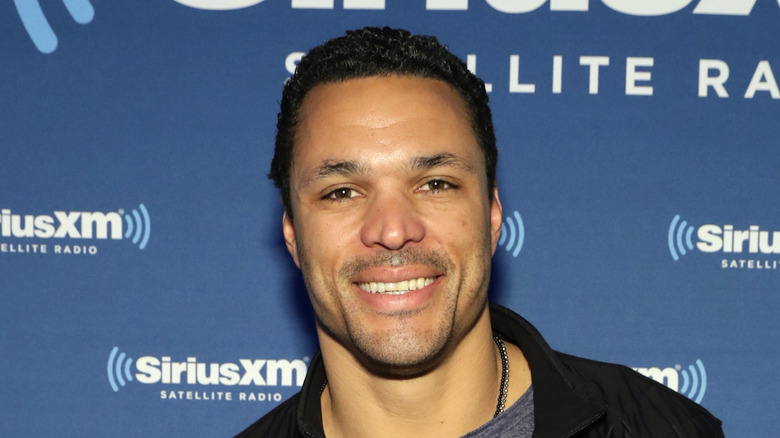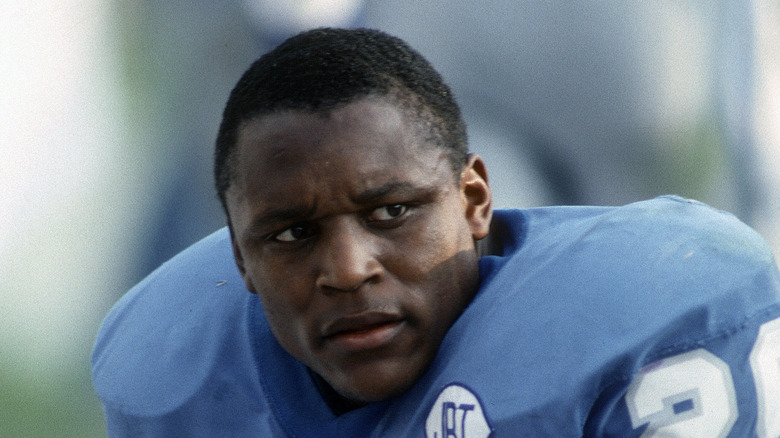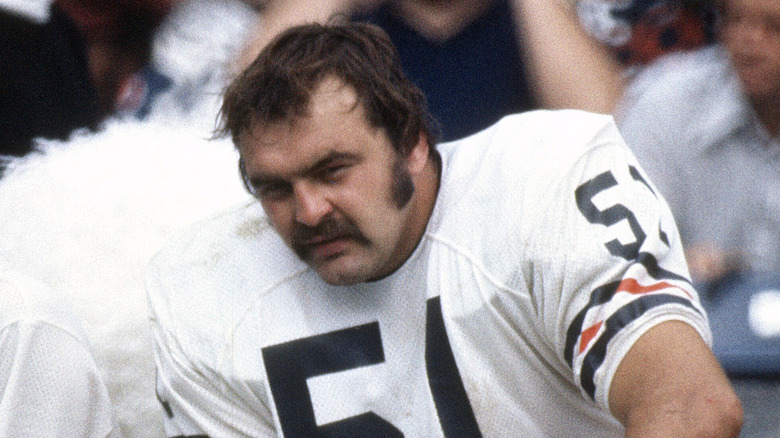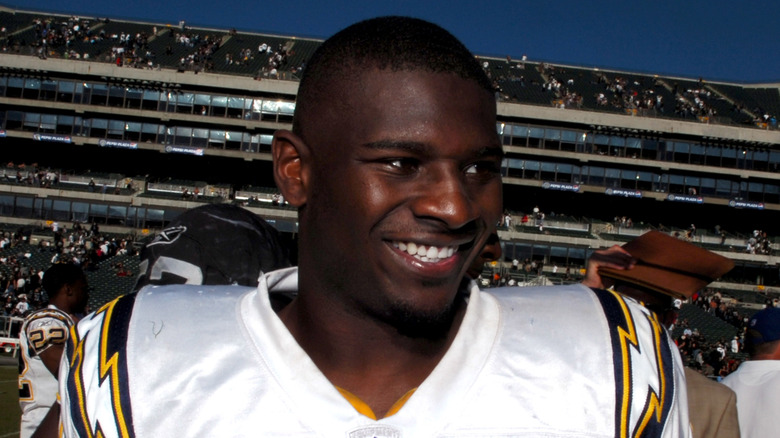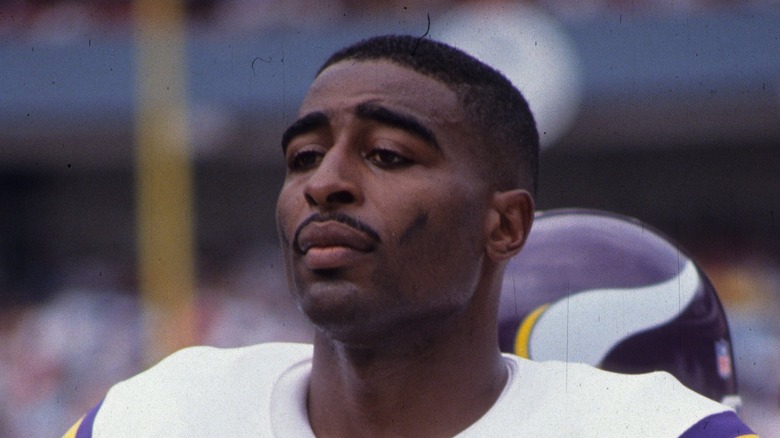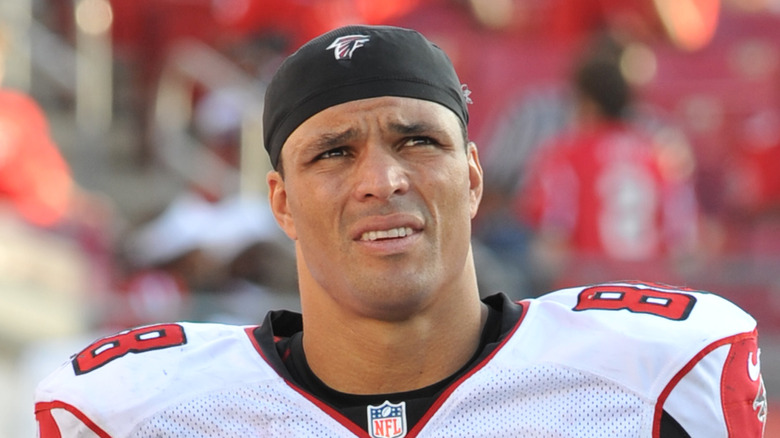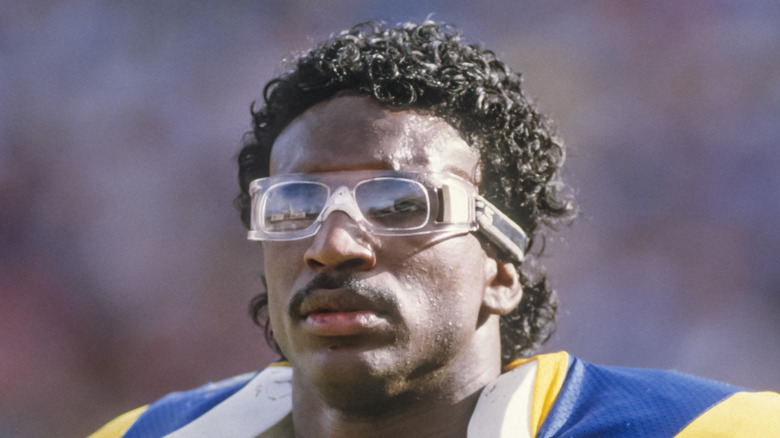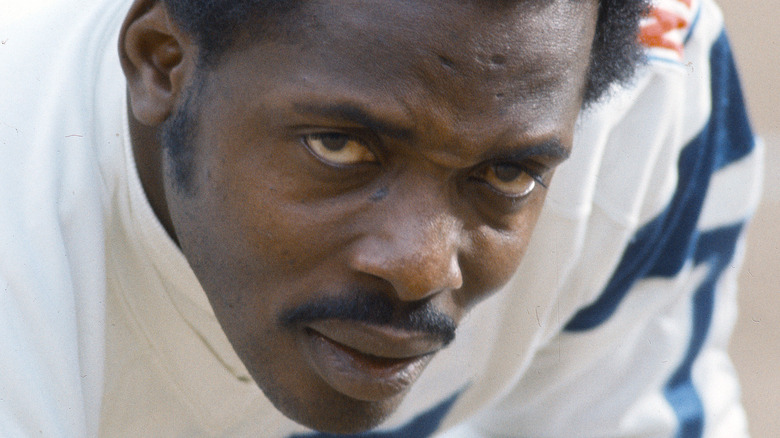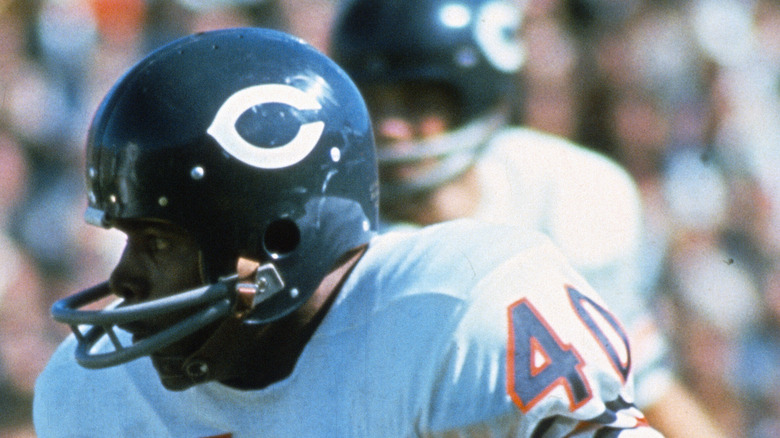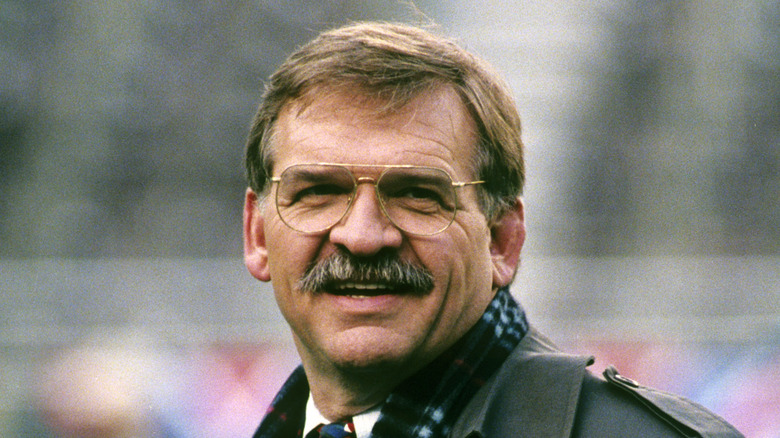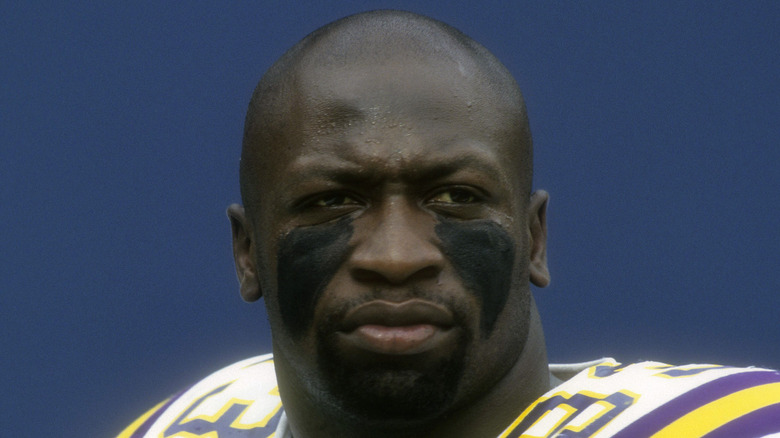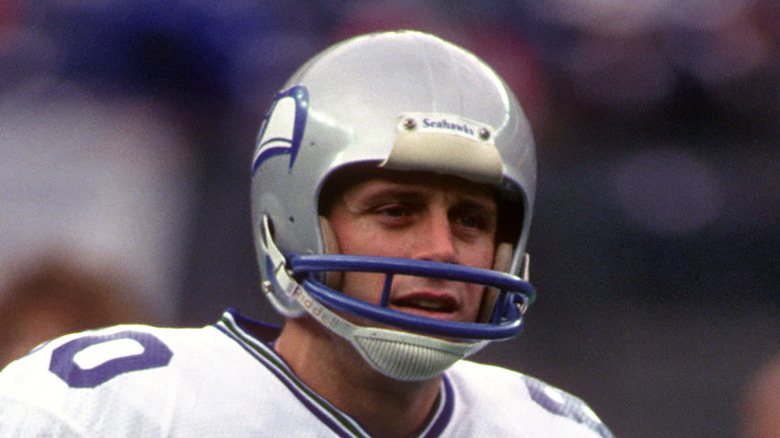History's Best NFL Athletes Who Never Made It To The Super Bowl
The Super Bowl is one of the biggest events in the sports world, and it is the one day in the NFL where the league's best teams and athletes battle for the title of national champions. The big game, viewed by millions year after year, has seen a number of surprising wins and losses, ranging from the underdog Philadelphia Eagles beating the New England Patriots, the then five-time reigning Super Bowl Champions, to the less-than-perfect New York Giants defeating the Patriots in Super Bowl XLII.
Over the years, there have been a number of talented players that have missed the opportunity to hold the Lombardi Trophy or obtain a bedazzled victory ring, ranging from Dan Marino to JJ Watt. But what about the players that were just as skilled but didn't even make it past the playoffs? Here are a number of record-breaking Hall of Fame players that never reached the Super Bowl during their careers.
Barry Sanders
Elusive, unpredictable, and agile, Barry Sanders is widely considered by sports enthusiasts as one of the greatest running backs in NFL history. Sanders grew up in Wichita, Kansas, where he developed a strong work ethic by often accompanying his father, a carpenter and roofer, to various jobs. When he reached North Wichita High School, he joined the football team and showed his incredible talent to the coaches. In his senior year, he earned Honorable Mention All-American and all-state honors with a record of 1,417 yards during his last seven games.
After high school, Sanders received scholarships to various colleges but ultimately decided to start at Oklahoma State University. During his college career at OSU, Sanders smashed existing records, leading the nation in rushing yards per game and yards per attempt. By the time he headed to the NFL Draft, Sanders had a record of 3,556 rushing yards in three seasons, with an average of 6.8 yards per rush attempt. In the 1989 NFL Draft, the Detroit Lions selected Sanders in the first round, and his nine-year career with the team was nothing short of astonishing.
As a Lion, Sanders dominated the field. His intensity and quickness led the team to the playoffs in his second year, but in the 1991 NFC Championship, the Lions lost to the Washington Redskins 41-10. The Lions had four playoff appearances during Sanders' career but were eliminated in the Wild Card round each time. Sanders retired in 1999 and never reached the Super Bowl.
Dick Butkus
Legendary Chicago Bears linebacker Dick Butkus was a force to be reckoned with in the 1960s and 1970s, with many considering him one of the most feared players in the NFL. Born and raised in Chicago, Butkus spent the entirety of his professional career in his home state, first playing as a fullback, linebacker, punter, and placekicker at Chicago Vocational High School. Following high school, Butkus attended the University of Illinois and was a linebacker on the team. During his time with the Fighting Illini, Butkus helped lead the team to the Rose Bowl in the 1963 season and had a whopping 374 tackles from 1962 to 1964.
In the 1965 NFL Draft, the Chicago Bears selected Butkus as the third overall pick in the first round. With the Bears, Butkus' made an instant impact on the team during his rookie year, with five interceptions, seven fumble recoveries, and one sack under his belt. His starting year with the Bears would unfortunately be the closest the team would ever get to the Super Bowl, with a winning, but disappointing, 9-5 record. For the remainder of his career with the Bears and as an NFL player, Butkus never reached the playoffs and retired in 1974 (due to a knee injury) with 22 interceptions and 27 fumble recoveries.
LaDainian Tomlinson
LaDanian Tomlinson holds the record as one of the greatest running backs in the history of the NFL, with a total of 13,684 rushing yards throughout his 11 seasons with the San Diego Chargers and New York Jets. And yet, the Hall of Famer described his career to Bleacher Report as "close but no cigar," because he never made it to the Super Bowl with either team. Tomlinson's love for sports blossomed at University High School in Texas, where he played basketball, football, and baseball. By his senior year, he garnered significant attention for his record-breaking season, rushing a total of 2,554 yards with 39 touchdowns.
Despite his impressive stats, Tomlinson wasn't highly sought out by college recruiters. He went on to attend Texas Christian University on an athletic scholarship in 1997, where he established himself as a serious contender for the NFL Draft. During his three years as a Horned Frog, Tomlinson boasted an impressive 5,263 rushing yards, ranking sixth in NCAA Division I history. In the 2001 NFL Draft, he was drafted as the fifth overall pick in the first round by the San Diego Chargers, and he ended his rookie year with 1,236 rushing yards. He had one of his best seasons in 2007, averaging 4.7 yards per carry, which helped lead the Chargers to the AFC Championship game. Against the Patriots, the Chargers lost 21-12, and Tomlinson spent one more season with the team before being released and being picked up by the Jets. He retired after two seasons in 2011.
Cris Carter
Outside of his career as an analyst, Cris Carter is known for being one of the best wide receivers in NFL history. Carter grew up in Middletown, Ohio, and took an interest in sports with his brother, Butch Carter, at a young age. In high school, Carter was recruited in both basketball and football but ultimately chose to play for the Ohio State University Buckeyes under the coaching of Earle Bruce. By the time he was a junior, Carter broke records and ended the season with 11 touchdowns, 69 receptions, and 1,127 yards. With his stats, Carter was likely to be a top contender in the NFL Draft, but his association with controversial sports agent Norby Walters made him ineligible for the 1987 season.
In the 1987 supplemental draft, the Eagles selected Carter in the fourth round, and during his time with the Philadelphia sports team, he had a total of 1,450 receiving yards. By 1990, Carter was released and later claimed off of waivers by the Minnesota Vikings for a $100 fee. His career with the Vikings established him as one of the league's greatest, and from 1993 to 2000, he had eight straight seasons of 1,000 or more yards. As a Viking, Carter made many playoff appearances, but unfortunately, in two conference championship games, one against the Falcons in 1998 and another against the Giants in 2000, the Vikings lost, and Carter never got a chance to play in the big game. He ultimately retired after one season with the Miami Dolphins in 2002.
Tony Gonzalez
Today, many may recognize Tony Gonzalez for his work as an analyst for CBS Sports, Fox Sports, and NFL on Prime Video, but Gonzalez is also a Hall of Fame tight end with a record of 15,127 receiving yards during his career. Gonzalez, like many NFL athletes, played sports in high school. At Huntington Beach High School, he played both basketball and football but ultimately made football his main focus. In his senior year, Gonzalez held an impressive record of 63 receptions for 945 yards and 13 touchdowns. For college, he attended UC Berkeley, and from 1994–1996, Gonzalez had 89 receptions for 1,302 yards, averaging 14.3 yards per carry.
A highly coveted player in the football world, Gonzalez was selected as the 13th overall pick in the first round of the 1997 NFL Draft by the Kansas City Chiefs. He played for the Chiefs for a total of 12 seasons and received four first-team All-Pros, four second-team All-Pros, and 11 Pro-Bowl selections with the team. In 2009, Gonzalez was traded to the Atlanta Falcons, where, despite being a 30-something veteran among younger players, he continued to shine. In his starting year, he had 83 receptions for 867 yards, but his best year in Atlanta would come in 2012, where he helped lead the team to the NFC Championship with 93 receptions and 930 yards. The Falcons suffered a devastating loss to the 49ers with a score of 28-24, and Gonzalez stayed in the league for one more year before retiring in 2013.
Eric Dickerson
In the 1980s, there was arguably no bigger sports personality than Eric Dickerson. Distinguishable by his prescription goggles, confident demeanor, and ambitious running ability, Dickerson was an electric running back on the field, and throughout his ten-year career in the NFL, he played for the LA Rams, Indianapolis Colts, LA Raiders, and Atlanta Falcons. His football career started at Sealy High School, where his record of 5,000 rushing yards for 82 touchdowns made him an attractive prospect for college recruiters from Southern Methodist University (SMU), Texas A&M, USC, and the University of Oklahoma.
Dickerson decided to attend SMU on an athletic scholarship. During his freshman year, he set the record for most rushing yards in a season, with 477 yards and six touchdowns. He shared carries with fellow players Craig James and Charles Waggoner, and the trio became known as the "Pony Express" for their strong running game. When the SMU was at the center of a slush fund scandal in the 1980s, Dickerson was entangled in the controversy, but was nonetheless drafted by the LA Rams as the second overall pick in the 1983 NFL Draft.
With the Rams, Dickerson was unstoppable. In his first three seasons, he had a total of 5,147 rushing yards with 46 total touchdowns, and by 1985, the team was one win away from reaching the Super Bowl. Unfortunately for Dickerson and the Rams, the 1985 NFC Championship game was a shutout (24-0) against the Bears. He played for another eight years before retiring in 1993.
Deacon Jones
With a nickname like "the Secretary of Defense," it's no surprise that Deacon Jones is highly regarded as one of the greatest defensive players in NFL history. The legendary defensive end played a variety of sports in high school but decided to pursue football in college and beyond. He attended South Carolina State in 1958, but had his scholarship revoked for participating in a civil rights protest. After a gap year, he attended Mississippi Vocational College in 1960, and only played one season of college football before he was accidentally discovered by a LA Rams scout in 1961.
Jones was drafted by the Rams as the 186th pick in the 14th round of the 1961 NFL Draft. During his 11 seasons with the team, Jones established himself as one of the most fearless and durable players in the league, with an astonishing 21.5 and 22 sacks in the 1967 and 1968 seasons, respectively. Along with Merlin Olsen, Rosey Grier and Lamar Lundy, Jones was a pivotal part of the "Fearsome Foursome," one of the NFL's most powerful and revered defensive lines. By 1969, the Rams made it to the Divisional Playoffs but lost to the Vikings in a close 23-20 game. After suffering a back injury, Jones was traded to the San Diego Chargers in 1972 and played two seasons on the team before ending his career with the Washington Redskins in 1974.
Gale Sayers
Along with Dick Butkus, Gayle Sayers, the iconic running back, made an incredibly huge impact with the Chicago Bears and established a legacy as one of the best to play the game. Sayers moved around during his childhood and settled in Omaha, Nebraska where he would play both track and football at Omaha Central High School. His efforts in high school garnered the attention of several college recruiters, but Sayers chose to attend the University of Kansas.
From 1962 to 1964, Sayers quickly earned the nickname "the Kansas Comet" for his elusive and swift athleticism. In his two years at Kansas, he rushed for 2,675 yards and was awarded with All-American honors not once, but twice.
Following a stellar college career, Sayers was selected as the fourth overall pick in the first round of the 1965 NFL Draft by the Chicago Bears. In his rookie year, Sayers had 867 rushing yards and 20 total touchdowns. Despite his impressive stats, the closest Sayers would get to the Super Bowl was the 1965 season with Chicago, with a record of 9-5. The running back spent the entirety of his career with the Bears and retired in 1971 due to complications from multiple knee injuries. He became the youngest person to be inducted into the Pro Football Hall of Fame in 1977 at the age of 34.
Dan Dierdorf
During his 12-year career with the St. Louis Cardinals from 1971 to 1983, Dan Dierdorf received five First-team All-Pros, one Second-team All-Pro, and made six Pro-Bowl appearances. The offensive tackle was known to be a force on the field, and along with players Roger Finney, Bob Young, Tom Banks, and Conrad Dobler, comprised the "Great Wall of St. Louis," an elite offensive line of notable players.
Dierdorf grew up in Canton, Ohio, coincidentally, where he would be inducted into the Pro Football Hall of Fame years later in his adulthood. He played football at Glenwood High School, and eventually was scouted by colleges like the University of Michigan, Michigan State, and Ohio State. He opted to play for the Michigan Wolverines, and he started at the school in 1967. Dierdorf's success in Michigan from 1967 to 1970 led to him being drafted by the Cardinals with the 43rd overall pick in the second round of the 1971 NFL Draft.
With the Cardinals, Dierdorf, along with the other offensive line players, allowed the fewest sacks throughout a consecutive five-year period. He recovered a total of seven fumbles and was on track to be the best of the best. During an extra-point attempt in 1979, Dierdorf sustained torn ligaments in his knee, and the injury ultimately led to his retirement in 1983. As a Cardinal, Dierdorf made the playoffs three different times, but never advanced to the Super Bowl.
John Randle
Former defensive tackle John Randle had a special drive instilled in him from a young age. He grew up in Mumford, Texas, and was raised by his mother, Martha, with his two brothers. Along with his siblings, Randle worked several small jobs to support his family, which gave him a strong work ethic by the time he reached high school. His local high school, Hearne High, was a ten-mile bus ride away, which interfered with his desire to play football despite his talent in the sport. With the encouragement of his mother, however, he pursued football, though he was never recruited by any of the high-profile teams. Instead, he attended Trinity Valley Community College before transferring to Texas A&M University–Kingsville.
In 1990, Randle signed a contract as an undrafted free agent with the Minnesota Vikings. He earned a starting position on the team his second year and had an impressive 9.5 sacks and 58 tackles that season. For the next decade with the Vikings, Randle had 114 sacks and 486 tackles, earning him six First-team All-Pros and seven Pro-Bowl selections. In the 97-98 season, Randle had a career high 15.5 sacks, and led the Vikings to the 1998 NFC Championship game, where the team ultimately lost to the Falcons 30-27. He reached the Conference Championship again in 2000, only to lose to the Giants in a shutout, 41-0. Following the loss, Randle signed with the Seattle Seahawks, and played for the team until his retirement in 2003.
Steve Largent
Before he served in the U.S. House of Representatives from 1994 to 2002, Steve Largent was one of the NFL's best wide receivers. Largent was drawn to sports from an early age and used it as a means to escape difficult aspects of his childhood, specifically his stepfather, who struggled with alcoholism. In high school, he dedicated himself to football and earned a scholarship to the University of Tulsa in 1972. At Tulsa, Largent consistently developed his skills and ended his collegiate career with a bang. In his junior year, he had 14 touchdowns and 884 receiving yards, which increased to 1,000 yards the following year.
In 1976, Largent was selected as the 117th overall pick in the fourth round of the NFL Draft by the Houston Oilers, who then traded him to the Seattle Seahawks. Largent played for a total of 14 seasons with the Seahawks and was one game away from making it to the Super Bowl in the 1983 AFC Championship Game. Despite the team's best efforts, the Seahawks lost to the LA Raiders 30-14. Largent appeared in three additional playoff games until his retirement in 1989, but never advanced to the Super Bowl during his impressive career that ended with a record of 100 touchdowns and 13,089 receiving yards.

